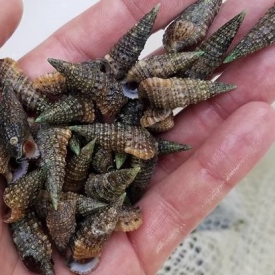10-20 Gallon CLEAN UP CREW-Blue Leg Hermit Crab, Astraea Snail, Emerald, Cerith
$49.99
10x Cerith Snails
20x Astrea Snails
1x Emerald Crab
10x Blue Leg Hermits
Blue Leg Hermit Crab, Algae Control, Aquarium, Live Corals, Inverts, CUC
Scientific Name: Clibanarius Tricolor
Approximate Size: 0.5-1.5 Inches
Difficulty: Easy
Preferred Diet: Scavenger
Restrictions: Cannot tolerate copper!!
DRIP ACCLIMATION REQUIRED.
Usually you want 1-2 blue legs per gallon
Most inverts do well under 73-78 Fahrenheit, PH 8.0-8.3, Salinity 1.022-1.025
| Scientific Name | Cerithium spp. | |
| Reef Compatible | Yes | |
| Care Level | Beginner | |
| Disposition | Peaceful | |
| Min. Tank Size | 10 gallons | |
| Mature Size | 1 inch | |
| Placement in tank | Any | |
| Diet | Omnivore | |
| Range | Eastern Pacific, Mexico, Caribbean |
Don’t let the Cerith Snail’s small adult size fool you. As well as having a gorgeous, elongated spiral shell, this active scavenger can consume large amounts of detritus, uneaten food, fish waste, and algae. Plus, this species of the Cerithium genus often burrows in your aquarium sand and helps maintain adequate oxygen levels in the substrate.
Native to the Caribbean and Eastern Pacific off the coast of Mexico, the Cerith Snail does best in larger, well-established reef systems with deep sand beds. This voracious feeder is most active at night. In fact, breeding pairs of Cerith Snails will lay their eggs on your aquarium glass just after dark in long, stringy curves. However, since these eggs take a while to develop, they are often consumed by other tankmates or removed from the water column by filtration before the eggs have a chance to hatch. The Cerith Snail is extremely difficult to breed in captivity. Not only is determining the sexes difficult, but the water parameters required to do so are unknown.
Like other invertebrates, the Cerith Snail is sensitive to high nitrate levels and copper based medications. It also requires a gradual acclimation process, preferably the drip acclimation method, since it is sensitive to even minute changes in water parameters.
The Astraea Turbo Snail has a unique shell and a ravenous appetite for algae. Unlike many bottom dwellers that are dressed in drab colors to better camouflage themselves against the sand bottoms, Astraea tecta boasts a pyramid-shape shell with beautiful, olive green coloration. Since some individuals have projections on the shell that give it a star-like outline, the Astraea Turob is also known as the Astraea Star Snail or Astraea Conehead Snail.
Though interesting to observe in your home aquarium, the Astraea Turbo Snail serves a greater function of cleaning algae-covered live rock. It is very adept at keeping your aquarium clean. In fact, this small herbivore prefers to feed on nuisance hair algae, as well as cyanobacteria and diatoms. Some aquarists also report that the Astraea Turbo Snail actually consumes the entire hair algae structure, which helps prevent immediate further algae growth.
The Astraea Turbo Snail prefers well-established aquariums with ample hiding places and sufficient room to roam. In addition to eating algae off of your live rock, this member of the Astraeinae family will also clean your aquarium glass. However, the Astraea Turbo Snail is not known to be climbers like other smaller-shelled snail species. Care needs to be taken to observe the daily activities of this hungry snail since it has difficulty righting itself if it falls or is knocked upside down.
Like other invertebrates, the Astrae Turbo Snail is sensitive to high nitrate levels and will not tolerate copper-based medications. The Astraea Conehead Snail requires a gradual acclimation period, preferably the drip acclimation method, he often over two hours, since it cannot tolerate even minute changes in water parameters. If sufficient food levels are not present, supplement the diet with blanched spinach or lettuce and vegetable-based tablet foods.
Approximate Purchase Size: 1/2″ to 1″
Emerald Crab overview
The Emerald Crab is well respected for its scavenging ability. It will enthusiastically feed on uneaten meaty foods and many types of nuisance algae. Unlike many other animals, Mithraculus sculptus will eat bubble algae and helps clean your aquarium of these algae. Its distinct, flat shiny green body and hairy legs easily identify the Emerald Crab.Native to the reefs of the Caribbean, the Emerald Crab is nocturnal and hides in caves and amongst rubble during the day. In the home aquarium, this member of the Majidae family requires a well-established aquarium with plenty of rockwork and hiding places. Once familiar with its surroundings, the Emerald Crab will venture out of hiding during the day to forage on algae.
Care needs to be taken to ensure an ample supply of food is available for the Emerald Crab. Many aquarists supplement the Emerald Crab’s diet with dried seaweed and chopped meaty foods, such as shrimp, as well as a quality pellet fish food.
Otherwise, this opportunistic feeder may turn to corals, invertebrates, or small fish for a food source. However, when well fed, most Emerald Crabs are very tolerant of their tankmates and highly compatible in reef environments. Like other invertebrates, the Emerald Crab does not tolerate copper-based medications or fluctuating water parameters.
Approximate Purchase Size: 1/2″ to 1-1/2″








There are no reviews yet.